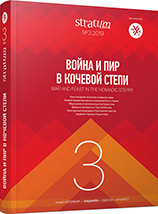Сцены сражения на золотом конусе из Передериевой Могилы и скифский миф о Колаксае
The Battle Scenes on the Golden Cone from Perederieva Mogyla and the Scythian Myth about Kolaxais
Author(s): Yurii B. PolidovychSubject(s): History, Archaeology, Cultural history, History of ideas, Ancient World, History of Religion
Published by: Издательский дом Stratum, Университет «Высшая антропологическая школа»
Keywords: Donetsk region; 4th century BC; Scythians; Perederieva Mogyla; legend about three brothers; genealogical myth; Targitaos; Kolaxais; Fereydun; royal power; sacrifice; military rituals;
Summary/Abstract: The article addresses the gold object found in 1988 in a grave-mound Perederieva Mogyla of the 4th century BC. It relates to objects of unknown purpose, which are conventionally called cones. Two battle scenes are depicted on the Perederieva Mogyla cone. An analysis of the iconography suggests that the scenes consistently represent two key episodes of the legend (myth) about three brothers. The first scene shows the conspiracy of the elder brothers, the second scene — the death of the younger brother. The legend of the three brothers is well known in the Iranian mythological and epic traditions. It tells about the sons of the hero Fereydun (Thraetaona in the Avesta) — Salm, Tur and Iraj. Fereydun divided the world into three kingdoms and gave them to his sons. The younger son became king in Iran, and the elder brothers envied this. They conclude an alliance and kill Iraj. Analyzing and comparing the Scythian and Iranian myths, the author comes to the conclusion that the Scythian hero Kolaxais corresponds to the Iranian Fereydun/Thraetaona, and the story of his sons is depicted on the cone. The death of his younger son was the first death, the first blood with which the history of human wars began. It is a symbolic sacrifice that is made to seize power. The legend of the three brothers became the basis of the concept of power among the Iranian peoples, including the Scythians. She was associated with important royal and military rituals, in which they used the golden cone.
Journal: Stratum plus. Археология и культурная антропология
- Issue Year: 2019
- Issue No: 3
- Page Range: 229-260
- Page Count: 32
- Language: Russian
- Content File-PDF

